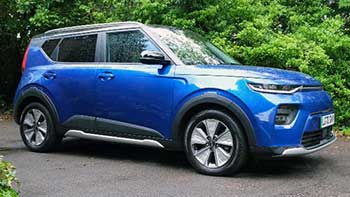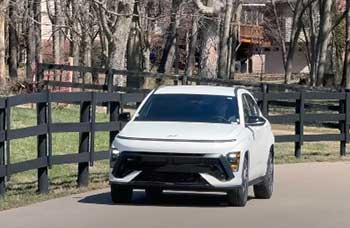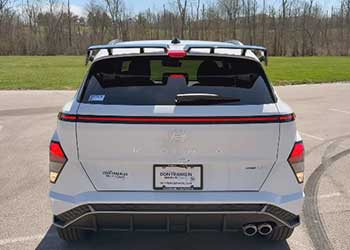As a car enthusiast, I’ve spent countless hours behind the wheel of compact SUVs. I’m thrilled to share my insights on two standout contenders: the Kia Soul and the Hyundai Kona. My goal is to help you navigate their strengths and weaknesses, from performance to practicality. This way, you can decide which fits your lifestyle.
This article unpacks their features, pros, and cons. It’s written from a conversational, first-person perspective. I’m blending real-world driving experiences with hard data. Whether you’re after quirky charm or modern flair, I’ve got you covered with a detailed comparison. My aim is to guide your choice.
Comparison Table of Kia Soul vs Hyundai Kona
| Feature | Kia Soul (2024) | Hyundai Kona (2025) |
| Starting MSRP | $20,190 | $24,250 |
| Engine (Base) | 2.0L 4-cylinder, 147 hp | 2.0L 4-cylinder, 147 hp |
| Fuel Economy (City/Hwy/Combined) | 29/35/31 MPG (EX trim) | 29/34/31 MPG (FWD base) |
| Cargo Space (Behind 2nd Row / Max) | 24.2 / 62.1 cu ft | 25.5 / 63.7 cu ft |
| Passenger Space | 102.2 cu ft total | 101 cu ft total |
| Drivetrain | Front-wheel drive only | FWD standard, AWD optional |
| Infotainment | 8-inch or 10.25-inch touchscreen | Dual 12.3-inch screens (higher trims) |
| Safety Rating | IIHS Top Safety Pick (2023 model year) | IIHS Top Safety Pick Plus (2025 model) |
| Warranty | 5-yr/60,000-mi basic, 10-yr/100,000-mi powertrain | 5-yr/60,000-mi basic, 10-yr/100,000-mi powertrain |
| Maintenance | No complimentary maintenance | 3-yr/36,000-mi complimentary maintenance |
My Journey with Compact SUVs
I’ve always been drawn to compact SUVs for their blend of practicality and personality. Over the years, I’ve test-driven dozens of models. These range from zippy crossovers to boxy wagons. The subcompact segment never fails to surprise me.
The Kia Soul and Hyundai Kona caught my attention. They are siblings under the Hyundai Motor Group umbrella. Yet, they carve out distinct identities. The Soul’s quirky, boxy charm contrasts with the Kona’s sleek, futuristic vibe. This makes them perfect candidates for a head-to-head showdown. My experiences on city streets, highway cruises, and even a few gravel paths inform this comparison. I aim to capture what it’s like to live with these vehicles day-to-day.
Design and First Impressions
The Kia Soul’s boxy silhouette is impossible to miss. Pulling up to a coffee shop in a 2024 Soul EX, its retro-modern design turned heads. The high roofline and upright stance give it a playful, almost toy-like appeal. But it’s practical too.

The cabin feels airy. There’s ample headroom that makes it feel larger than its compact footprint suggests.
I found the Soul’s bold color options, like Inferno Red, and its customizable GT-Line trim added a sporty edge. The flat-bottom steering wheel is hard to ignore.
In contrast, the 2025 Hyundai Kona feels like it rolled out of a sci-fi movie. Its angular lines and sleek LED headlights give it a futuristic edge. During a test drive, I noticed the Kona’s lower profile and tighter stance. This made it feel more like a lifted hatchback than a traditional SUV.
The interior’s dual 12.3-inch screens and minimalist dashboard screamed modern sophistication. However, the glossy plastics on lower trims felt a bit cheap. The Kona’s design is polarizing—you’ll either love its bold angles or find it too aggressive.
Soul Pros:
- Unique, retro-modern styling.
- Spacious, airy cabin.
- Bold color options.
Soul Cons:
- Boxy shape may not appeal to everyone.
- Some interior plastics feel low-rent.
Kona Pros:
- Futuristic design.
- Sleek, modern interior.
- Premium vibe on higher trims.
Kona Cons:
- Polarizing exterior.
- Less headroom due to lower roofline.
Performance and Driving Experience
Both the Soul and Kona share a base 2.0-liter four-cylinder engine. It produces 147 horsepower. This is paired with a continuously variable transmission (CVT). Driving the Soul through city traffic, I found its acceleration adequate but not exhilarating.

It’s peppy enough for daily commutes. However, the CVT can feel sluggish when you push it.
The Soul’s handling is surprisingly nimble for its boxy shape, making parking a breeze. Yet, on a winding mountain road, the Soul’s soft suspension leaned more than I’d like. It prioritizes comfort over sportiness.
The Kona, on the other hand, offers a bit more zest. Its optional 1.6-liter turbocharged engine (195 hp) in the N Line trim gave me a grin-inducing boost. This happened during a highway merge. Even the base engine felt slightly more responsive than the Soul’s. This is thanks to the Kona’s tighter suspension tuning.
I took a Kona SEL AWD through a snowy backroad. Its all-wheel-drive system provided confident grip. This is where the Soul’s front-wheel-drive setup would’ve struggled. However, the Kona’s ride can feel harsh over potholes, especially with overinflated tires. I learned this during one bumpy test drive.
Soul Pros:
- Nimble handling.
- Comfortable ride.
- Easy to maneuver.
Soul Cons:
- Sluggish CVT.
- No AWD option.
- Soft suspension limits cornering.
Kona Pros:
- Optional turbo engine.
- AWD available.
- Sharper handling.
Kona Cons:
- Harsher ride.
- Base engine lacks punch.
Fuel Efficiency and Range
Fuel economy is a big deal for me. This is especially true with gas prices fluctuating. The Kia Soul EX trim shines here. It has an EPA-estimated 29/35/31 MPG (city/highway/combined). Its 14.3-gallon fuel tank means fewer stops at the pump. This gives me about 450 miles of range on a road trip. The Soul’s smaller size and front-wheel-drive setup make it slightly more efficient than most Kona trims.
The Kona’s base front-wheel-drive model matches the Soul closely at 29/34/31 MPG. But its all-wheel-drive versions drop to 24/29/26 MPG. With a smaller 13.2-gallon tank, the Kona’s range hovers around 400 miles. I noticed the Kona’s fuel economy took a hit during aggressive driving. The Soul, however, stayed consistent. For eco-conscious drivers, the Kona Electric’s 131/105 MPGe is a game-changer. But it comes at a higher price point ($34,470 for 2024 model) compared to the Soul’s starting MSRP.
Soul Pros:
- Better fuel economy.
- Larger fuel tank.
- Longer range.
Soul Cons:
- No hybrid or electric option.
Kona Pros:
- Electric variant available.
- Competitive base MPG.
Kona Cons:
- Smaller fuel tank.
- AWD models less efficient.
Interior Comfort and Space
Sliding into the Soul’s cabin feels like stepping into a roomy loft. Its upright design maximizes rear headroom and legroom. This makes it a favorite for my taller friends. The 24.2 cubic feet of cargo space behind the second row easily swallowed a weekend’s worth of camping gear. Folding the seats down gave me 62.1 cubic feet for bulkier items. The Soul EX’s dual-zone climate control kept my passenger and me comfortable. The optional eight-way power driver’s seat was a nice touch for long drives.

The Kona’s interior is more intimate. It focuses on front-seat comfort.
Its 56.8 inches of front shoulder room and generous legroom made me feel less cramped than in the Soul. But rear passengers complained about the tighter 38.3 inches of headroom.
The Kona’s 25.5 cubic feet of cargo space behind the second row was sufficient for groceries. But its 63.7 cubic feet with seats folded edged out the Soul slightly. The Kona’s heated front seats and optional ventilated seats were a hit. But I missed the Soul’s dual-zone climate control on base trims.
Soul Pros:
- Spacious rear seating.
- Larger base cargo area.
- Dual-zone climate control available.
Soul Cons:
- Less front shoulder room.
- Some cheap interior materials.
Kona Pros:
- Roomier front seating.
- Slightly larger max cargo.
- Premium features like ventilated seats.
Kona Cons:
- Tighter rear headroom.
- No dual-zone climate on base trims.
Technology and Infotainment
Tech is where these SUVs flex their muscles. The Soul’s 10.25-inch touchscreen (available on higher trims) is crisp and intuitive. It comes with Apple CarPlay and Android Auto as standard. During a road trip, I loved the UVO link system’s navigation. The optional eight-speaker Harman Kardon audio system turned my commute into a concert. The Soul’s digital key feature, which lets you control climate settings via smartphone, was a unique perk I didn’t expect.
The Kona’s dual 12.3-inch screens steal the show. The new ccNC infotainment system is lightning-fast. The larger displays make navigation a breeze. I found the Kona’s interface simpler to use than the Soul’s. Most controls were just a tap or two away. However, the Kona lacks a head-up display. Its Bose audio system, while solid, didn’t match the Soul’s Harman Kardon for clarity. The Kona’s wireless charging pad and multiple USB-C ports kept my devices juiced. But I wished for the Soul’s climate control integration.
Soul Pros:
- Intuitive touchscreen.
- Premium audio available.
- Unique digital key features.
Soul Cons:
- Smaller screen on base trims.
- No head-up display.
Kona Pros:
- Larger dual screens.
- Faster infotainment.
- More USB-C ports.
Kona Cons:
- No head-up display.
- Audio slightly less impressive.
Safety and Driver Assistance
Safety is non-negotiable for me. Both SUVs deliver. The Soul’s Kia Drive Wise suite includes forward collision avoidance, blind-spot monitoring, and lane-keeping assist. Its 2023 model year earned an IIHS Top Safety Pick rating, which is reassuring. However, NHTSA gave it a 4-star overall rating. I appreciated the Soul’s lane change assist and intelligent speed limit assist during highway drives. These features kept me alert and within legal limits.
The Kona edges ahead with its 2025 IIHS Top Safety Pick Plus rating. This reflects superior performance in updated crash tests. Its Hyundai SmartSense system includes standard rear cross-traffic collision-avoidance assist and a surround-view monitor on the Limited trim. This saved me from a parking lot fender-bender. The Kona’s front and rear seatbelt pretensioners and optional AWD add extra peace of mind. This is especially true in slick conditions.
Soul Pros:
- Comprehensive safety suite.
- Strong crash test history.
Soul Cons:
- Rear cross-traffic warning not standard on all trims.
- 4-star NHTSA rating.
Kona Pros:
- Top Safety Pick Plus.
- Advanced safety features standard.
- AWD option.
Kona Cons:
- Some features limited to higher trims.
Price and Value
Price is where the Soul shines. Starting at $20,190, it undercuts the Kona’s $24,250 base price by over $4,000. During my test drives, the Soul LX felt like a steal. It offers rear privacy glass, a 10.25-inch touchscreen (on higher trims), and a robust warranty (5-year/60,000-mile basic, 10-year/100,000-mile powertrain). The Soul’s lower cost didn’t sacrifice features, making it ideal for budget-conscious buyers like me.
The Kona’s higher price comes with perks. These include complimentary maintenance for three years or 36,000 miles. This saved me a few hundred bucks on oil changes and tire rotations. Its resale value is slightly better (34.1% depreciation vs. the Soul’s 37.1% over five years). But the gap isn’t huge. The Kona’s premium features, like ventilated seats and AWD, justify the cost for those willing to splurge. But I found the Soul’s value proposition hard to beat.
Soul Pros:
- Lower starting price.
- Excellent warranty.
- Great value.
Soul Cons:
- No complimentary maintenance.
- Slightly higher depreciation.
Kona Pros:
- Better resale value.
- Free maintenance.
- Premium features.
Kona Cons:
- Higher starting price.
- Some features cost extra.
Reliability and Ownership
Reliability matters when you’re clocking thousands of miles yearly. Consumer Reports ranks Kia higher than Hyundai. The Soul’s 7.6/10 reliability rating from iSeeCars beats the Kona’s 5.9/10. My Soul test vehicle felt solid. There were no rattles or quirks after weeks of driving. The EPA also rates the Soul higher for emissions. It produces up to 8 pounds less smog-causing pollutants every 15,000 miles.
The Kona’s build quality is tight. But I noticed minor interior creaks on lower trims. Its complimentary maintenance is a big win. It covers everything from oil changes to inspections. Both vehicles share identical warranty terms. But the Kona’s higher trim levels offer luxury touches like power-adjustable seats. The Soul reserves these for its EX trim.
Read More: Kia Sorento vs. Toyota RAV4
Soul Pros:
- Higher reliability rating.
- Lower emissions.
- Solid build.
Soul Cons:
- No free maintenance.
- Fewer luxury options.
Kona Pros:
- Complimentary maintenance.
- Premium features on higher trims.
Kona Cons:
- Lower reliability rating.
- Minor interior creaks.
My Verdict
Choosing between the Kia Soul and Hyundai Kona depends on your priorities. If you’re after affordability, quirky style, and a spacious cabin, the Soul is your match. Its lower price, better fuel economy, and larger cargo area make it a practical choice. This is true for families or budget-conscious drivers. However, if you crave modern tech, all-wheel-drive capability, and top-tier safety, the Kona’s worth the extra cash. Its futuristic design and premium features appeal to those who want a cutting-edge ride.
For me, the Soul’s value and charm won out. During a weeklong test, its roomy interior and peppy handling made every drive a joy. This was true even if it lacked the Kona’s turbo kick. But I urge you to test-drive both. You’ll feel the difference and know which one’s your vibe. Whether you pick the Soul’s retro swagger or the Kona’s sleek edge, you’re getting a stellar compact SUV. It’ll turn heads and fit your life.
Read More: Kia Sorento Hybrid vs. Hyundai Santa Fe Hybrid
Frequently Asked Questions (FAQ)
It depends on your needs. The Soul offers better value and space. The Kona excels in safety and AWD options. Test-drive both to decide.
The Kona isn’t discontinued. It’s available for 2025 with a refreshed design and electric variant.
The Hyundai Kona is the closest match. It offers similar size, features, and performance.
The Kia Soul is the most comparable. It shares a similar platform and engine options.
Conclusion
You’re now armed with everything you need to weigh the Kia Soul against the Hyundai Kona. I’ve shared my experiences driving these compact SUVs. These range from their quirky designs to their practical features. This is to help you find the perfect fit. The Soul’s budget-friendly price and spacious interior make it a standout for value-driven buyers.
Meanwhile, the Kona’s modern tech and AWD appeal to those seeking a premium edge. Test-drive them. Feel their vibe. Choose the one that sparks joy for you. Your next adventure awaits!

